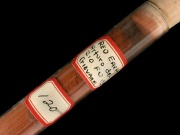Difference between revisions of "Red iron oxide"
Jump to navigation
Jump to search
(username removed) |
|||
| (3 intermediate revisions by 2 users not shown) | |||
| Line 2: | Line 2: | ||
== Description == | == Description == | ||
| − | Turned off - same as iron oxide red- Iron oxides, in hydrated and anhydrous forms, produce a wide variety of red shades ranging from light, bright red to a deep purplish red. They can be natural, earth pigments ([ | + | Turned off - same as iron oxide red- Iron oxides, in hydrated and anhydrous forms, produce a wide variety of red shades ranging from light, bright red to a deep purplish red. They can be natural, earth pigments ([[hematite|hematite]], [[Indian%20red|Indian red]], Venetian red) or synthetically prepared pigments ([[light%20red|light red]]). All iron oxide reds are stable, permanent pigments with good tinting strength. Iron oxides generally provide the color in ochers and siennas. |
== Synonyms and Related Terms == | == Synonyms and Related Terms == | ||
| Line 8: | Line 8: | ||
red iron oxide; red ocher; red ochre; haematite; hematite; Indian red; caput mortum; rouge; Persian red;Tuscan red, Pompeian red; light red; Venetian red; terra Pozzuoli; English red; pozzuolana, terra di Pozzuoli; bengara (Jap.); benigara (Jap.); Roter Ocker (Deut.) | red iron oxide; red ocher; red ochre; haematite; hematite; Indian red; caput mortum; rouge; Persian red;Tuscan red, Pompeian red; light red; Venetian red; terra Pozzuoli; English red; pozzuolana, terra di Pozzuoli; bengara (Jap.); benigara (Jap.); Roter Ocker (Deut.) | ||
| + | ==Physical and Chemical Properties== | ||
{| class="wikitable" | {| class="wikitable" | ||
|- | |- | ||
| Line 14: | Line 15: | ||
|- | |- | ||
! scope="row"| Density | ! scope="row"| Density | ||
| − | | 4.2-5.3 | + | | 4.2-5.3 g/ml |
|} | |} | ||
== Comparisons == | == Comparisons == | ||
| − | [[media: | + | [[media:download_file_209.pdf|Properties of Common Abrasives]] |
| − | + | ==Resources and Citations== | |
| − | |||
| − | == | ||
* Ralph Mayer, ''A Dictionary of Art Terms and Techniques'', Harper and Row Publishers, New York, 1969 (also 1945 printing) | * Ralph Mayer, ''A Dictionary of Art Terms and Techniques'', Harper and Row Publishers, New York, 1969 (also 1945 printing) | ||
| − | * | + | * Pigments Through the Ages - http://webexhibits.org/pigments/indiv/overview/redochre.html |
* R.Feller, M.Curran, C.Bailie, 'Identification of Traditional Organic Colorants Employed in Japanese Prints and Determination of their Rates of Fading', ''Japanese Woodblock Prints'', Allen Memorial Art Museum, Oberlin College, Oberlin, 1984 | * R.Feller, M.Curran, C.Bailie, 'Identification of Traditional Organic Colorants Employed in Japanese Prints and Determination of their Rates of Fading', ''Japanese Woodblock Prints'', Allen Memorial Art Museum, Oberlin College, Oberlin, 1984 | ||
Latest revision as of 12:37, 19 September 2022
Description
Turned off - same as iron oxide red- Iron oxides, in hydrated and anhydrous forms, produce a wide variety of red shades ranging from light, bright red to a deep purplish red. They can be natural, earth pigments (Hematite, Indian red, Venetian red) or synthetically prepared pigments (Light red). All iron oxide reds are stable, permanent pigments with good tinting strength. Iron oxides generally provide the color in ochers and siennas.
Synonyms and Related Terms
red iron oxide; red ocher; red ochre; haematite; hematite; Indian red; caput mortum; rouge; Persian red;Tuscan red, Pompeian red; light red; Venetian red; terra Pozzuoli; English red; pozzuolana, terra di Pozzuoli; bengara (Jap.); benigara (Jap.); Roter Ocker (Deut.)
Physical and Chemical Properties
| Mohs Hardness | 5.5 - 6.5 |
|---|---|
| Density | 4.2-5.3 g/ml |
Comparisons
Properties of Common Abrasives
Resources and Citations
- Ralph Mayer, A Dictionary of Art Terms and Techniques, Harper and Row Publishers, New York, 1969 (also 1945 printing)
- Pigments Through the Ages - http://webexhibits.org/pigments/indiv/overview/redochre.html
- R.Feller, M.Curran, C.Bailie, 'Identification of Traditional Organic Colorants Employed in Japanese Prints and Determination of their Rates of Fading', Japanese Woodblock Prints, Allen Memorial Art Museum, Oberlin College, Oberlin, 1984
